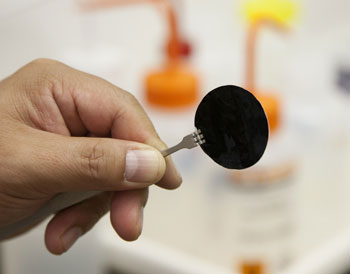 Lawrence Livermore National Laboratory scientists and collaborators are developing a new military uniform material that repels chemical and biological agents using a novel carbon nanotube fabric. The material will be designed to undergo a rapid transition from a breathable state to a protective state. The highly breathable membranes would have pores made of a few-nanometer-wide vertically aligned carbon nanotubes that are surface modified with a chemical warfare agent-responsive functional layer. Response to the threat would be triggered by direct chemical warfare agent attack to the membrane surface, at which time the fabric would switch to a protective state by closing the CNT pore entrance or by shedding the contaminated surface layer.
Lawrence Livermore National Laboratory scientists and collaborators are developing a new military uniform material that repels chemical and biological agents using a novel carbon nanotube fabric. The material will be designed to undergo a rapid transition from a breathable state to a protective state. The highly breathable membranes would have pores made of a few-nanometer-wide vertically aligned carbon nanotubes that are surface modified with a chemical warfare agent-responsive functional layer. Response to the threat would be triggered by direct chemical warfare agent attack to the membrane surface, at which time the fabric would switch to a protective state by closing the CNT pore entrance or by shedding the contaminated surface layer.
« The uniform will be like a smart second skin that responds to the environment, » said Francesco Fornasiero, LLNL’s principal investigator for the Defense Threat Reduction Agency (DTRA)-funded project. « Without the need of an external control system, the fabric will be able to switch reversibly from a highly breathable state to a protective one in response to the presence of the environmental threat. In the protective state, the uniform will block the chemical threat while maintaining a good breathability level. »
Source: Lawrence Livermore National Laboratory



